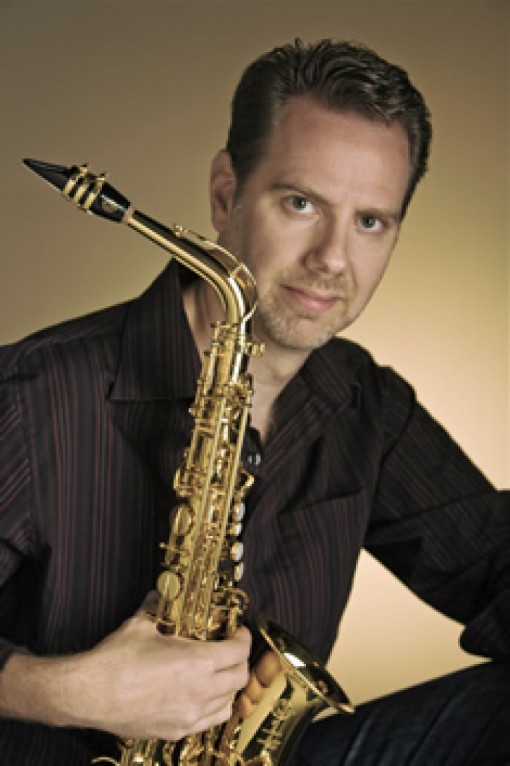John Adams’ new concerto shows sax appeal in American premiere

Timothy McAllister was the soloist in the American premiere of John Adams’ Saxophone Concerto, performed Friday night with Marin Alsop and the Baltimore Symphony Orchestra.
By composing a saxophone concerto, John Adams has elevated the saxophone from its second-class status in the classical world.
At least such were the hopes of some people, including perhaps the composer, for this new half-hour work. It is a heavy burden for a concerto, indeed just one of a growing number of concertos to feature the saxophone, to bear.
The U.S. premiere of Adams’s Saxophone Concerto, given by the Baltimore Symphony Orchestra at its home in Meyerhoff Symphony Hall on Friday night, unveiled a piece that is soulful and vivacious but hardly music that will transform the role of the saxophone in classical music.
In fact, the saxophone is not as maligned historically as the oversized chip on the shoulder of some saxophonists might lead you to believe. The instrument, with its sharp and distinctive sound, has parts in orchestral scores by Bizet, Prokofiev, Vaughan Williams, Ravel, and Berg. It became one of the central instruments in the jazz ensemble and, through that role, is widely heard in popular music of many varieties. In addition to quite a few concertos for solo saxophone, some of them rather good, there are several concertos for saxophone quartet, a trend that is likely the envy of bassoonists and bass clarinets.
Adams has already been particularly generous to the instrument, including major parts for saxophone quartet in his opera Nixon in China and Fearful Symmetries as well as a virtuoso alto sax solo in City Noir.
His Saxophone Concerto is cast in two movements, a form familiar from other Adams works, with a fast and slow movement combined into a long first movement, capped off by a virtuosic finale. Adams wrote the concerto for saxophone virtuoso Tim McAllister, who played it Friday with consummate polish and verve. Adams pushes the soloist to the edge with dizzying scales and disjunct leaping passages, often bouncing off the orchestra in syncopated or otherwise disorienting rhythmic patterns.
Conductor Marin Alsop danced and wiggled around the podium, seeming to lead as much with her elbows and head as her stick arm, at times with half of her body in one pattern and half in another.
The players of the Baltimore Symphony Orchestra produced a lush sound in the first movement, especially on the rising chords that go with the main theme and the bluesy background of the ensuing slow section. The fast sections, especially the closing movement — dubbed by Adams “a funk-rondo with a fast, driving pulse” — sounded a little ragged at times, with some uncertainty, especially in the strings, about precisely where some of their accents fell. Adams himself conducted the work’s world premiere last month in Australia with the Sydney Symphony Orchestra, and one of those performances, broadcast on the Internet, sounded tighter and more confident.
All in all, Adam’s Saxophone Concerto is a worthy addition to a small but growing repertory for this instrument.
In the latest bit of unimaginative programming from Marin Alsop, the Adams premiere was sandwiched between Rimsky-Korsakovs’s Scheherazade and Tchaikovsky’s 1812 Overture, neither of which was all that memorably performed. In remarks from the podium, Alsop joked about the incongruity of the three works, as if someone else were responsible.
Alsop gave Scheherazade as much oomph as she could in the fourth movement, with exciting and solid sounds from the brass, but the third movement came off very soupy (in spite of generally fine solos from concertmaster Jonathan Carney), and there were disjointed ensemble issues throughout.
In Tchaikovsky’s overplayed piece of bombast, the U.S. Navy Band Sea Chanters had a balanced sound in a mostly unaccompanied hymn that introduced the overture, a memorial tribute to the victims of the mass shooting earlier in the week at the Navy Yard in Washington, D.C. Unfortunately, this small group had to be amplified, to unflattering effect, to compete with the orchestra in the conclusion of the work. The piece was included, nominally, as part of the BSO’s ongoing celebration of the 200th anniversary of the conclusion of the War of 1812. To mark the locally relevant end of that conflict, when Francis Scott Key saw the American flag still flying over Fort McHenry in Baltimore Harbor, the orchestra has commissioned new arrangements of the Star-Spangled Banner. The one heard at this concert, by local composer James Lee, was all Hollywood schmaltz.
_________________________
The Baltimore Symphony Orchestra has teetered at the edge of the nation-wide orchestral solvency crisis for some years. In response to the economic downturn, the musicians agreed to a pay cut in 2008, a reduction that was finally ended this year, bringing the musicians’ salaries almost back to where they were.
Still, things are far from rosy in the BSO’s budget, for many positions vacated by musicians, especially in the string sections, have been allowed to remain vacant. The number of subscription concerts has also dwindled slightly, and many of them are devoted to the banal repetition of a small number of dull, crowd-pleasing pieces. This continues to be the most disappointing part of Marin Alsop’s Baltimore tenure in recent years.
The program will be repeated 8 p.m. Saturday at the Music Center at Strathmore in Bethesda and 3 p.m. Sunday at Meyerhoff Symphony Hall. bsomusic.org.
Tim McAllister will also play the Adams’ Saxophone Concerto with David Robertson and the St. Louis Symphony Orchestra October 5 and 6.